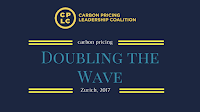Several different carbon-pricing approaches would help reduce emissions, and some would be fair as well, researchers report.
Putting a price on carbon, in the form of a fee or tax on the use of fossil fuels, coupled with returning the generated revenue to the public in one form or another, can be an effective way to curb emissions of greenhouse gases. That's one of the conclusions of an extensive analysis of several versions of such proposals, carried out by researchers at MIT and the National Renewable Energy Laboratory (NREL).
What's more, depending on the exact mechanism chosen, such a tax can also be fair and not hurt low-income households, the researchers report.
The analysis was part of a multigroup effort to apply sophisticated modeling tools to assess the impacts of various proposed carbon-pricing schemes. Eleven research teams at different institutions carried out the research using a common set of starting assumptions and policies. While significant details differed, all the studies agreed that carbon taxes can be effective and, if properly designed, need not be regressive.
An overview report on the 11 studies appears Thursday in the journal Climate Change Economics, along with reports on the individual team results. The MIT and NREL team included former MIT postdoc Justin Caron, MIT Joint Program on the Science and Policy of Global Change Co-Director John Reilly, and Stuart Cohen and Maxwell Brown of NREL.
Reilly, who is a senior lecturer at MIT's Sloan School of Management, says the groups looked at several options for a carbon tax and use of the resulting revenue. They considered two different starting values ($25 and $50 per ton of carbon emissions produced), and two different rates of increase (1 percent or 5 percent per year), as well as three different approaches to dispensing the revenue: an equal rebate to every household, a tax break for individuals, or a corporate tax break.
Of the different levels of fees, the team found, not surprisingly, that the highest starting value and the highest rate of increase produced the greatest emissions reductions. But the study showed that even the lowest taxation rates could in themselves lead to reductions sufficient to meet the U.S. near-term commitment under the 2015 Paris Agreement on climate change, Reilly says.
However, the most efficient way of achieving those reductions, in terms of overall impact on the economy, is to use the revenue to reduce taxes on capital -- corporate profits or investment income. Given the relatively high capital taxes in the U.S. (at the time this study was completed) such cuts spur economic growth more than cuts in other taxes or direct rebates to households. However, that option is also the most regressive, with its impact disproportionally falling on lower-income households.
At the other extreme, the option of sending equal payments to everyone was found to be the least efficient for the overall economy, but also the least regressive. Individual tax breaks came in somewhere in between on both criteria.
But the researchers say another scenario, combining the basic strategy of providing tax breaks to corporations but adding a rebate to the low-income families most affected by the tax, could virtually eliminate the regressive aspects of the tax at very little cost in overall efficiency, and thus might be the most appealing option. It could have appeal both for conservatives concerned about the costs of such a program, and for liberals concerned about its possible impacts on those at the lower end of the economic spectrum.
Read more at Carbon Taxes Can Be Both Fair and Effective, MIT Study Shows

No comments:
Post a Comment